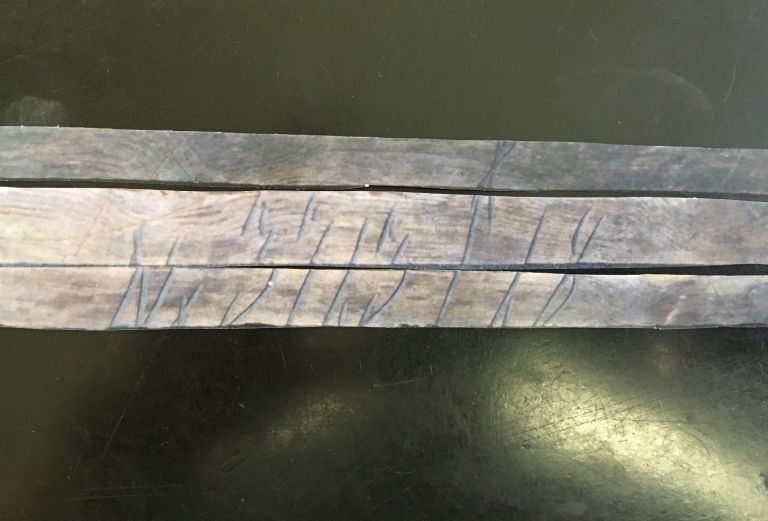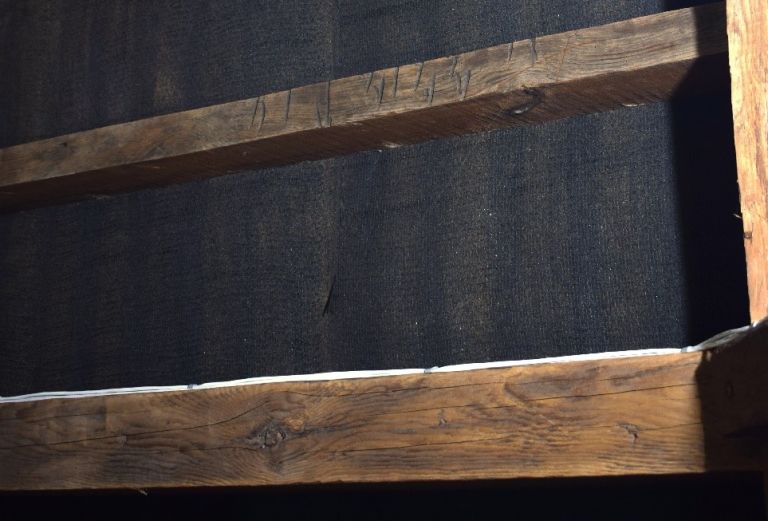
By Alexis Haslam, community archaeologist
For those of you who have been wondering where I have been for the last few months (or for those of you who haven’t noticed one way or another and were never really quite sure what I did anyway), I am currently writing up the standing building report for the restoration project. This is essentially a record that is required as part of the planning consent, recounting the history of each room that has undergone repair, redecoration or alteration throughout the works. An absolutely fascinating read it will certainly be, and I’m sure none of you can wait to get your hands on a copy of this epic tome.
Anyway, having now finished both the ground and first floors, I have moved on to my personal favourite part of the Palace, the roof. A place where wonderful elements of Tudor craftsmanship and carpentry reside in quiet contemplation next to botched repairs from the 20th century, spaghetti junctions of poor wiring and long abandoned wasps nests.
What I’m going to write about now however concerns the more recent elements of the Palace’s pretty damn fine roof.

In the picture above are the rafters belonging to the north wing of the Tudor courtyard. Look closely and you can see a series of marks on them. Despite looking like the etchings of a troubled soul imprisoned in the roof space by a callous Bishop for some kind of religious heinousness, they are in fact what are known as ‘Baltic Shipping Marks’ and they date to the 19th century. So what can they tell us about our roof, other than it was built at some point in the 1800s, replacing an earlier and presumably irreparable version?
Well, after reading that well known and thoroughly engrossing paper ‘Baltic shipping marks on nineteenth-century timber: their deciphering and a proposal for an innovative characterization of old timber’ I decided some detective work was necessary. I tried to contact one of the authors of this totally mind altering piece, Louis Vandenabeele, at the Vrije Universiteit Brussel, but according to the email bounceback he has ‘scarce access to the internet until April 1st 2019’. So more fool me.
Still, undeterred by this initial setback I took a closer look at those timbers and an idea dawned on me. What if I was to print off a copy of that photo, cut the rafters out and see if they fitted together?

Holy cow! Check that out! They fit together! Who’d have thunk it?! But what does it all mean? What are these bizarre runes trying to tell us about the 19th century timber industry in northern and eastern Europe? Now there is absolutely no way I’m going to be able to sleep until I have solved this utterly bizarre mystery. My thoughts are distressed. A 19th century timber merchant is clearly trying to communicate something to me from beyond the grave. Things have just become very serious indeed.
Well, using the aforesaid paper, we can determine that these marks, inscribed into the timber using a tool known as a rase knife (now you see what I did with the title), read (possibly) as follows:
Nx3763 ж 68
But why? What does this madness mean I hear you ask? Now we’re going to get deeply technical…
Much of the timber supplied to Western Europe throughout the 19th century originated from Norway and other countries around the Baltic Sea such as Germany, Poland, Lithuania, Latvia, Estonia, Russia, Finland and Sweden. This was usually in the form of Scots Pine (often known as Baltic fir, Red deal or Yellow deal) or Norway Spruce (otherwise known as Norway fir or White deal). The situation in Britain however was somewhat more complex as there had been a continual raising of taxes on European timber from the late 18th century onwards. This was an attempt to protect the timber industry within the North American colonies and It wasn’t until the 1860’s that the tax levels became more balanced. If this is true, then our roof post-dates 1860, and is unlikely to have been constructed during Blomfield’s renovations of 1853.
Timber was generally felled in the winter, and come the rising spring thaw it was floated downriver to the Baltic shores. It was here that the sawmills cut the timber to size, and by the 1850’s these mills were steam powered and heavily industrialised, creating a huge boom in timber export. Once cut, the timber was then stacked and housed in storage grounds according to size and quality before being shipped abroad in the period between May and mid-December, at which point the sea began to freeze.
What many of the newly established sawmills didn’t have however was a good understanding of the timber markets, and for this they used merchants’ houses as middlemen. This is where the marking system becomes important as exporters needed to distinguish between different sources, qualities and sizes of timber. The consumer would also be able to verify that their purchase was correct. Assessment was undertaken by individuals known as ‘brackers’ who were trained to sort and mark timber upon inspection. In Danzig, Riga, Memel and Stettin brackers were employed directly by the authorities and official marks were used on the timber due for export.
So what do our marks symbolise then, what do they mean? The most important symbol present on the rafters is the ж. This is the official stamp of Danzig, with one x symbolizing first grade timber, two symbolising second grade and three symbolising third grade. Our timber has one x, although it is possible we are missing others. Nx3763 refers to the balk number, whilst the 68 is probably a measurement, although these values have yet to be clarified.
So the work of a bracker in Danzig tells us that our roof was built with timber from this port, most probably after 1860. Quite a journey for a considerable lump of lumber. It still isn’t clear under which Bishop the roof was rebuilt, although if I were to hazard a guess I’d probably go with Bishop Tait (1856–1868). A plane man, but knot averse to branching out and spending a few leaves when required…